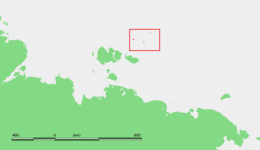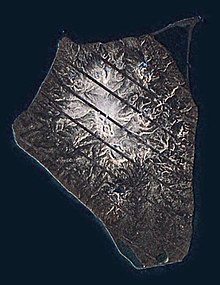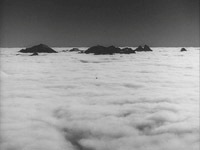| Native name: | |
|---|---|
 Map of the De Long Islands. Map of the De Long Islands. | |
 Map showing the location of the group Map showing the location of the group | |
| Geography | |
| Location | East Siberian Sea |
| Coordinates | 76°08′28″N 152°43′59″E / 76.141111°N 152.733056°E / 76.141111; 152.733056 |
| Archipelago | De Long Islands |
| Total islands | 5 |
| Area | 77 km (30 sq mi) |
| Length | 10.8 km (6.71 mi) |
| Width | 8.7 km (5.41 mi) |
| Highest elevation | 123 m (404 ft) |
| Administration | |
| Russia | |
| Federal subject | Far Eastern Federal District |
| Republic | Yakutia |
| Demographics | |
| Population | 0 |
Zhokhov Island (Russian: Остров Жохова, romanized: Ostrov Zhokhova; Yakut: Жохов Aрыыта, romanized: Joqov Arııta) is an island in the East Siberian Sea, situated 128 km north east of Novaya Sibir Island, the easternmost of the New Siberian Islands. Administratively the island belongs to the Yakutia administrative division of Russia.
Geography
Zhokhov Island is part of the De Long group. The nearest island is Vilkitsky Island, the southernmost island of the group. Zhokhov is 10.8 km (6.7 mi) in length and has an area of 77 km (30 sq mi). The highest point of the island is 123 m (404 ft).
Although the island itself is unglaciated, the sea surrounding Zhokhov Island is covered with fast ice, even during the summer, and the climate is severe.
 |
Geology
Zhokhov Island is an eroded late Cenozoic stratovolcano. Deeply cut seacliffs expose alternating flows of massive and blister lava, agglomerate and tuff. The exposed throat of this volcano is filled with columnar jointed basalts. The surrounding volcanic edifice consists of interlayered picrite–olivine basalts lava flows and beds of volcanic ash containing large volcanic bombs. The basalt lava flows range in age from 1.2 to 10 Ma according to K–Ar dating. The basalts contain xenoliths of sandstones, limestones, granites, syenites, and dolerites. Rare limestone xenoliths contain middle Carboniferous, tropical, marine invertebrate fossils.
Vegetation
Rush/grass, forb, cryptogam tundra covers the Zhokhov Island. It is tundra consisting mostly of very low-growing grasses, rushes, forbs, mosses, lichens, and liverworts. These plants either mostly or completely cover the surface of the ground. The soils are typically moist, fine-grained, and often hummocky.
History
Mesolithic humans occupied the island as early as 6000 BCE. Tools of stone, bone, antler, and ivory have been found, as well as wooden arrow shafts and a sledge runner. Animal remains suggest a culture dependent on the hunting of polar bears and reindeer. Evidence published in 2017 suggests that the early inhabitants of Zhokhov Island were among the first humans to selectively breed dogs. Findings indicate that larger dogs may have been bred for hunting and smaller dogs weighing 16 kilograms (35 lb) to 25 kilograms (55 lb) were bred for pulling sleds. DNA extracted from a 9,500-year-old dog, Zhokhov, named after the island, contributed significant genetic material to the Greenland Dog, the Alaskan Malamute and the Siberian Husky.
In modern times, Zhokhov Island was discovered by the 1910–1915 Russian Arctic Ocean Hydrographic Expedition under Boris Vilkitsky on the ships Vaygach and Taymyr. It was originally named Novopashenniy Island, after Piotr Alekseyevich Novopashenniy (1881–1950) Captain of icebreaker Vaygach, but in 1926 it was renamed after Lieutenant Alexey Zhokhov, a member of the expedition.
Climate
| Climate data for Zhokov Island | |||||||||||||
|---|---|---|---|---|---|---|---|---|---|---|---|---|---|
| Month | Jan | Feb | Mar | Apr | May | Jun | Jul | Aug | Sep | Oct | Nov | Dec | Year |
| Record high °C (°F) | −7.8 (18.0) |
−2.8 (27.0) |
−7.8 (18.0) |
−3.0 (26.6) |
7.2 (45.0) |
11.0 (51.8) |
14.5 (58.1) |
18.0 (64.4) |
7.5 (45.5) |
11.0 (51.8) |
−1.7 (28.9) |
−3.2 (26.2) |
18.0 (64.4) |
| Mean daily maximum °C (°F) | −25.5 (−13.9) |
−26.5 (−15.7) |
−24.2 (−11.6) |
−17.4 (0.7) |
−6.9 (19.6) |
−0.1 (31.8) |
2.7 (36.9) |
1.4 (34.5) |
−2.6 (27.3) |
−11.1 (12.0) |
−20.1 (−4.2) |
−24.2 (−11.6) |
−14.1 (6.6) |
| Daily mean °C (°F) | −28.3 (−18.9) |
−29.3 (−20.7) |
−27.2 (−17.0) |
−20.4 (−4.7) |
−9.0 (15.8) |
−1.5 (29.3) |
1.1 (34.0) |
0.3 (32.5) |
−4.3 (24.3) |
−13.8 (7.2) |
−22.9 (−9.2) |
−26.9 (−16.4) |
−16.6 (2.1) |
| Mean daily minimum °C (°F) | −31.6 (−24.9) |
−32.4 (−26.3) |
−30.7 (−23.3) |
−24.4 (−11.9) |
−12.0 (10.4) |
−3.3 (26.1) |
−0.6 (30.9) |
−1.9 (28.6) |
−6.6 (20.1) |
−17.1 (1.2) |
−26.1 (−15.0) |
−29.9 (−21.8) |
−19.5 (−3.1) |
| Record low °C (°F) | −46.1 (−51.0) |
−48.0 (−54.4) |
−45.0 (−49.0) |
−38.0 (−36.4) |
−26.0 (−14.8) |
−15.0 (5.0) |
−7.6 (18.3) |
−8.9 (16.0) |
−23.1 (−9.6) |
−33.0 (−27.4) |
−38.0 (−36.4) |
−43.0 (−45.4) |
−48.0 (−54.4) |
| Average precipitation mm (inches) | 13.6 (0.54) |
12.3 (0.48) |
7.8 (0.31) |
33.6 (1.32) |
20.2 (0.80) |
63.8 (2.51) |
68.2 (2.69) |
114.9 (4.52) |
53.1 (2.09) |
50.1 (1.97) |
31.1 (1.22) |
9.5 (0.37) |
478.2 (18.83) |
| Source: | |||||||||||||
In popular culture

Zhokhov Island is mentioned in Stanley Kubrick's Dr. Strangelove or: How I Learned to Stop Worrying and Love the Bomb as a place where the Russians built the doomsday device.
Ostrov Zhokhova is also mentioned in the Soviet "sad comedy" film by Georgii Danelia "Osennii Marafon" (Autumn Marathon). The film's "hero" Andrei Buzykin's daughter and her husband depart to take up a job in the weather station on Zhokhov Island, to Andrei's horror.
See also
References
- Respublika Sakha (Yakutiya) Land Feature Database Archived September 27, 2007, at the Wayback Machine
- Ershova, V.B., Lorenz, H., Prokopiev, A.V., Sobolev, N.N., Khudoley, A.K., Petrov, E.O., Estrada, S., Sergeev, S., Larionov, A. and Thomsen, T.B., 2016. The De Long Islands: A missing link in unraveling the Paleozoic paleogeography of the Arctic. Gondwana Research , 35, pp.305-322.
- Kos'ko, M. and Korago, E., 2009. Review of geology of the new Siberian islands between the Laptev and the East Siberian Seas, North East Russia. Stephan Mueller Special Publication Series, 4, pp.45-64.
- Makeev, V.M., Davydov, V.K., Ustritsky, V.I., 1991. Discovery of middle Carboniferous deposits with tropic fauna on the De Long Islands. Paleozoic Stratigraphy and Paleontology of the Arctic . Sevmorgeologia, Leningrad, pp. 167–170.
- CAVM Team, 2003, Circumpolar Arctic Vegetation Map. Scale 1:7,500,000. Conservation of Arctic Flora and Fauna (CAFF) Map No. 1. U.S. Fish and Wildlife Service, Anchorage, Alaska.
- Pitul'ko, V. V. (1993). "An Early Holocene Site in the Siberian High Arctic". Arctic Anthropology. 30 (1): 13–21. JSTOR 40316326.
- Grimm, David (May 26, 2017). "Earliest evidence for dog breeding found on remote Siberian island". Science. 356 (6340). doi:10.1126/science.aan6897.
- "Sled dogs are closely related to 9,500-year-old 'ancient dog'". ScienceDaily. 25 June 2020. Retrieved 4 August 2020.
- Starokadomski, L. M. and O. M. Cattley, 1919, "Vilkitski's North-East Passage, 1914-15". The Geographical Journal. vol. 54, no. 6, pp. 367–375.
- "Weather Averages for Zhokov Island (1955-1993)". climatebase.ru. Retrieved 17 December 2014.
- Walker, A., S. Taylor, U. Ruchti, 1999, Stanley Kubrick, Director. W. W. Norton & Company, New York, New York. 376 pp.
Further reading
- Anisimov, M.A., and V.E. Tumskoy, 2002, Environmental History of the Novosibirskie Islands for the last 12 ka. 32nd International Arctic Workshop, Program and Abstracts 2002. Institute of Arctic and Alpine Research, University of Colorado at Boulder, pp 23–25.
- Headland, R. K.,1994, OSTROVA DE-LONGA ('De Long Islands'), Scott Polar Research Institute, University of Cambridge, Cambridge, United Kingdom.
- Schirrmeister, L., H.-W. Hubberten, V. Rachold, and V.G. Grosse, 2005, Lost world - Late Quaternary environment of periglacial Arctic shelves and coastal lowlands in NE-Siberia. 2nd International Alfred Wegener Symposium Bremerhaven, October, 30 - November 2, 2005.